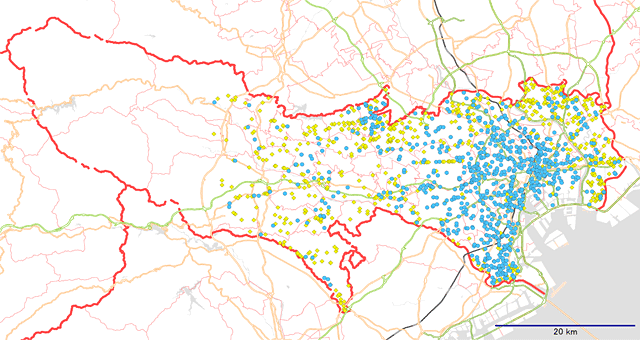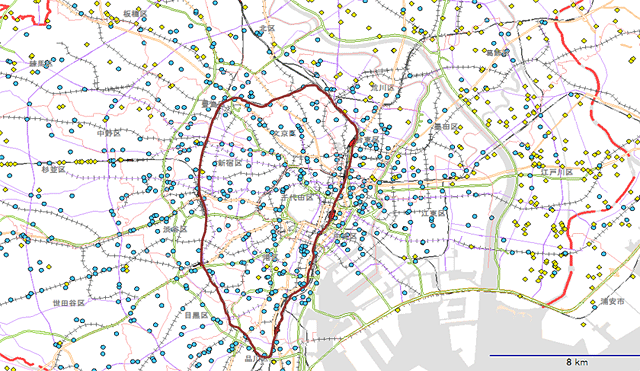Storage business in the three most populated prefectures (Tokyo, Kanagawa, Osaka) - Tokyo
Mr. Akira Sugawara
Yano Research Institute Ltd.
Although storage services have spread all over Japan, they are concentrated in highly populated urban areas. This report is the first in a three-part series about the storage business in the three most populated prefectures, Tokyo, Kanagawa and Osaka.
I would like to examine the current state of the storage business in the three prefectures with the highest populations, Tokyo, Kanagawa and Osaka. Here, in part one, I look at Tokyo.
Tokyo is a focal point for people, things and money. As you can see below, Tokyo is number one in Japan according to various statistical data. To put this in perspective, Tokyo Metropolis has the 45th largest land area. (Osaka Prefecture has the 46th and Kagawa Prefecture the 47th.)
[Statistics in which Tokyo is number one in Japan]
| Population |
No. of households |
No. of migrations (excessinflux) |
| Polulation density (highest) |
Average household size (lowest) |
No. of one-person households |
| No. of residences |
Rate of home ownership (lowest) |
No. of apartment buildings |
| No. of housing starts |
No. of businesses |
No. of emplyees |
| Gross product wighin perfecture |
Perfectura income |
|
With a large number of people, small dwelling floor areas, and a big consumer appetite, what Tokyo lacks is storage. In the rental storage field, Tokyo has the most operational business units and rooms among all the prefectures, with about 40% of all nationwide storage concentrated within the city. In the container storage field, Tokyo has the second highest number of operational business units after Saitama Prefecture, but the highest number of rooms.
Let me describe the storage services in the Tokyo area using GIS data and statistical data.
Development of rental storage and container storage in Tokyo

(Blue = rental storage, Yellow = container storage)
In Tokyo Metropolis, as of July 2013, approximately 1,900 rental storage and container storage business units have been developed.
The above mapping data is self-explanatory. The city center area is nearly all blue. As you move further away from the city center, although still in Tokyo you can see gradually more and more yellow indicating container storage, particularly in the so-called suburban areas (west of ring road No.7).
Still in Tokyo, there are hardly any storage service business units in mountainous and coastal areas. There are few people living in both such areas. In coastal areas there are rows of ports, factories, warehouses etc., including some storage services in the form of trunk-room (so-called warehouses) too, but the number of rental storage and container storage business units is extremely small.
[Tokyo municipal districts - Ranking for storage business units]
Tokyo
Metropolis |
Population |
Rental storage
business units |
Container storage
business units |
Total business
units |
| Ota-ku |
651,113 |
95 |
39 |
134 |
| Adachi-ku |
622,952 |
24 |
98 |
122 |
| Edogawa-ku |
633,949 |
25 |
92 |
117 |
| Setagaya-ku |
799,758 |
62 |
13 |
75 |
| Itabashi-ku |
506,952 |
32 |
40 |
72 |
| Katsushika-ku |
424,001 |
15 |
56 |
71 |
| Minato-ku |
168,060 |
65 |
3 |
68 |
| Machida-shi |
397,746 |
7 |
57 |
64 |
| Hachioji-shi |
529,226 |
10 |
52 |
62 |
| Higashikurume-shi |
113,811 |
25 |
33 |
58 |
Looking at the ranking of administrative districts within Tokyo Metropolis for the number of storage business units, the results show that nearly all of the most populated districts (1st: Setagaya-ku, 2nd: Nerima-ku, 3rd: Ota-ku, 4th: Edogawa-ku, 5th: Adachi-ku) also have many storage business units. Only the second most populated administrative district, Nerima-ku, was positioned low down the ranking in 12th place (with 55 storage business units) in spite of its urban population. This suggests there may be dormant opportunities in Nerima-ku.
As for the relative numbers of rental storage and container storage business units, Minato-ku and Machida-shi in 7th and 8th places illustrate things most clearly. Being in central Tokyo, Minato-ku has nearly all rental storage and only three container storage business units. Suburban Machida-shi, on the other hand, has nearly all container storage and only seven rental storage business units.
Development of rental storage and container storage in central Tokyo

(Bold red line = Yamanote Line)
If we zoom in on central Tokyo and look inside the loop of the Yamanote Line, shown in bold red, we can see that nearly all business units are rental storage. There are only five container storage business units within the Yamanote Line (as of July 2013). Incidentally, three of the 23 special wards have no container storage, namely, Chuo-ku, Shibuya-ku and Bunkyo-ku.
In the five special wards of central Tokyo which have the highest concentration of office buildings (Chiyoda-ku, Chuo-ku, Minato-ku, Shinjuku-ku and Shibuya-ku), land is so expensive that, apart from coin-payment car parks, buildings have to be built high enough to effectively utilize space, otherwise costs (rental fees) would be extremely high. Although these areas by their very nature have little unused land (empty lots), they do have many vacant buildings and vacant floors that have been effectively used to create a lot of rental storage.
About the Yano Research Institute
The Institute conducts comprehensive research and analysis on appropriate themes from a micro and macro perspective to determine trends in market size, business share, future prospects, trends among major players, and the like in a broad range of business fields.
We focused early on the storage business field, which continues to grow, and we have provided detailed investigative reports based on thorough reporting since 2010.
We are making a significant contribution to improving transparency in the storage business industry, by analyzing the future prospects, potential, and issues in a market that had scarce information.